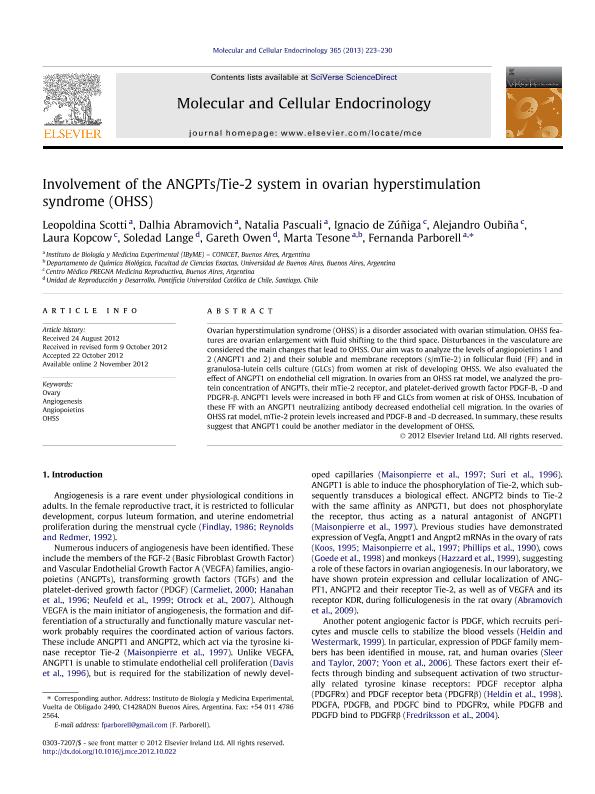Artículo
Involvement of the ANGPTs/Tie-2 system in ovarian hyperstimulation syndrome (OHSS)
Scotti, Leopoldina ; Abramovich, Dalhia Nurit
; Abramovich, Dalhia Nurit ; Pascuali, Natalia Marisa
; Pascuali, Natalia Marisa ; de Zúñiga, Ignacio Javier; Oubiña, Alejandro; Kopcow, Laura; Lange, Soledad; Owen, Gareth; Tesone, Marta
; de Zúñiga, Ignacio Javier; Oubiña, Alejandro; Kopcow, Laura; Lange, Soledad; Owen, Gareth; Tesone, Marta ; Parborell, Maria Fernanda Agustina
; Parborell, Maria Fernanda Agustina
 ; Abramovich, Dalhia Nurit
; Abramovich, Dalhia Nurit ; Pascuali, Natalia Marisa
; Pascuali, Natalia Marisa ; de Zúñiga, Ignacio Javier; Oubiña, Alejandro; Kopcow, Laura; Lange, Soledad; Owen, Gareth; Tesone, Marta
; de Zúñiga, Ignacio Javier; Oubiña, Alejandro; Kopcow, Laura; Lange, Soledad; Owen, Gareth; Tesone, Marta ; Parborell, Maria Fernanda Agustina
; Parborell, Maria Fernanda Agustina
Fecha de publicación:
30/01/2013
Editorial:
Elsevier Ireland
Revista:
Molecular And Cellular Endocrinology.
ISSN:
0303-7207
Idioma:
Inglés
Tipo de recurso:
Artículo publicado
Clasificación temática:
Resumen
Ovarian hyperstimulation syndrome (OHSS) is a disorder associated with ovarian stimulation. OHSS features are ovarian enlargement with fluid shifting to the third space. Disturbances in the vasculature are considered the main changes that lead to OHSS. Our aim was to analyze the levels of angiopoietins 1 and 2 (ANGPT1 and 2) and their soluble and membrane receptors (s/mTie-2) in follicular fluid (FF) and in granulosa-lutein cells culture (GLCs) from women at risk of developing OHSS. We also evaluated the effect of ANGPT1 on endothelial cell migration. In ovaries from an OHSS rat model, we analyzed the protein concentration of ANGPTs, their mTie-2 receptor, and platelet-derived growth factor PDGF-B, -D and PDGFR-β. ANGPT1 levels were increased in both FF and GLCs from women at risk of OHSS. Incubation of these FF with an ANGPT1 neutralizing antibody decreased endothelial cell migration. In the ovaries of OHSS rat model, mTie-2 protein levels increased and PDGF-B and -D decreased. In summary, these results suggest that ANGPT1 could be another mediator in the development of OHSS.
Palabras clave:
Ovario
,
Angiogenesis
,
Angiopoietinas
,
Ohss
,
Rats
,
Sprague-Dawley
Archivos asociados
Licencia
Identificadores
Colecciones
Articulos(IBYME)
Articulos de INST.DE BIOLOGIA Y MEDICINA EXPERIMENTAL (I)
Articulos de INST.DE BIOLOGIA Y MEDICINA EXPERIMENTAL (I)
Citación
Scotti, Leopoldina; Abramovich, Dalhia Nurit; Pascuali, Natalia Marisa; de Zúñiga, Ignacio Javier; Oubiña, Alejandro; et al.; Involvement of the ANGPTs/Tie-2 system in ovarian hyperstimulation syndrome (OHSS); Elsevier Ireland; Molecular And Cellular Endocrinology.; 365; 2; 30-1-2013; 223-230
Compartir
Altmétricas



